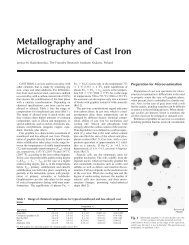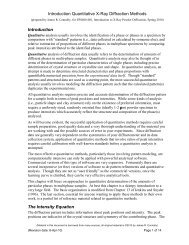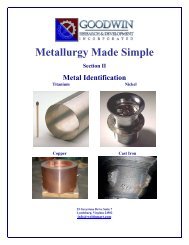ITP Metal Casting: 2002 Metal Casting Industry of the Future ...
ITP Metal Casting: 2002 Metal Casting Industry of the Future ...
ITP Metal Casting: 2002 Metal Casting Industry of the Future ...
You also want an ePaper? Increase the reach of your titles
YUMPU automatically turns print PDFs into web optimized ePapers that Google loves.
THE CHALLENGE<br />
<strong>Metal</strong> casting is one <strong>of</strong> <strong>the</strong> most energy-intensive industries in <strong>the</strong> U.S. manufacturing sector. It is<br />
also one <strong>of</strong> <strong>the</strong> only major U.S. manufacturing industries that is dominated by small businesses.<br />
These unique characteristics have helped drive <strong>the</strong> need for public-private R&D collaboration.<br />
Energy-Intensive <strong>Industry</strong><br />
In 1998, <strong>the</strong> U.S. metal casting industry (NAICS 3315) spent $1.2 billion purchasing an estimated<br />
235 trillion Btu. The amount <strong>of</strong> energy used by <strong>the</strong> metal casting industry is equivalent to that used<br />
by residents in New Hampshire, New Mexico, Rhode Island, Wyoming, and Hawaii combined. 1 If<br />
captive foundries are included, <strong>the</strong> estimated energy consumption for metal casting increases to<br />
328 trillion Btu. 2<br />
Energy intensive processes in metal casting include melting, mold making, core making, and o<strong>the</strong>r<br />
activities. (Energy Use in <strong>Metal</strong> <strong>Casting</strong>, page 7). The <strong>Metal</strong> <strong>Casting</strong> <strong>Industry</strong> <strong>of</strong> <strong>the</strong> <strong>Future</strong> is<br />
funding research to improve energy efficiency in <strong>the</strong>se processes. This research is improving yield,<br />
extending die and mold life, and reducing post-cast energy requirements. A <strong>2002</strong> analysis <strong>of</strong><br />
current <strong>Metal</strong> <strong>Casting</strong> IOF research projects estimates that <strong>the</strong> current R&D portfolio will save 23.4<br />
trillion Btu annually in 2010. This is estimated to increase to 101 trillion Btu in 2020.<br />
<strong>Metal</strong> casting R&D is a component <strong>of</strong> <strong>the</strong> overall EERE strategy to improve energy efficiency<br />
nationwide and to contribute to <strong>the</strong> goals outlined in <strong>the</strong> National Energy Policy. It is contributing to<br />
<strong>the</strong> EERE mission “to streng<strong>the</strong>n America’s energy security, environmentally quality, and economic<br />
vitality through public-private partnerships that:<br />
1. promote energy efficiency and productivity;<br />
2. bring clean, reliable, and affordable energy technologies to <strong>the</strong> marketplace; and<br />
3. make a difference in <strong>the</strong> everyday lives <strong>of</strong> Americans by enhancing <strong>the</strong>ir energy choices<br />
and <strong>the</strong>ir quality <strong>of</strong> life.” 3<br />
Small Business <strong>Industry</strong> with a Nationwide Impact<br />
The majority <strong>of</strong> metal casters are small businesses. Eighty percent <strong>of</strong> <strong>the</strong> estimated 2,950 metal<br />
casting facilities employ fewer than 100 people, 14% employ between 100 and 250 people, and<br />
only 6% employ more than 250 people. <strong>Industry</strong>-wide, an estimated 225,000 people are employed<br />
in metal casting. Moreover, <strong>the</strong> industry is widely dispersed throughout <strong>the</strong> country, eliminating<br />
opportunities for geographic based intra-industry coordination. In fact, metal casters are located<br />
throughout all 50 states. The industry is vital to <strong>the</strong> economic well being <strong>of</strong> <strong>the</strong> communities where<br />
<strong>the</strong>y are located. Although <strong>the</strong> industry is found nationwide, ten states account for 84% <strong>of</strong> metal<br />
castings shipments. These states are Ohio, Indiana, Wisconsin, Alabama, Michigan, Pennsylvania,<br />
4<br />
Illinois, Tennessee, California, and Texas.<br />
1 1998 Manufacturing Consumption <strong>of</strong> Energy Report, U.S. Department <strong>of</strong> Energy, Energy Information Administration Tables N.11.1,<br />
and Survey 1998 Annual Energy Review, U.S. Department <strong>of</strong> Energy, Energy Information Administration, Table 1.6<br />
2<br />
Using AFS <strong>2002</strong> <strong>Metal</strong><strong>Casting</strong> Forecast & Trends, <strong>the</strong> ratio <strong>of</strong> metal casting shipments (NAICS 3315) to captive foundry casting<br />
production was calculated. This ratio was applied to industry energy consumption for NAICS 3315,1998 Manufacturing<br />
Consumption <strong>of</strong> Energy Report, U.S. Department <strong>of</strong> Energy, Energy Information Administration Tables N.11.1 , to estimate energy<br />
consumption in captive foundries.<br />
3 U.S. Department <strong>of</strong> Energy, Assistant Secretary for Energy Efficiency and Renewable Energy, Organization Mission and Functions,<br />
<strong>2002</strong>, pg.1<br />
4<br />
www.afsinc.org/Trends/FactsandFigures.htm 3








